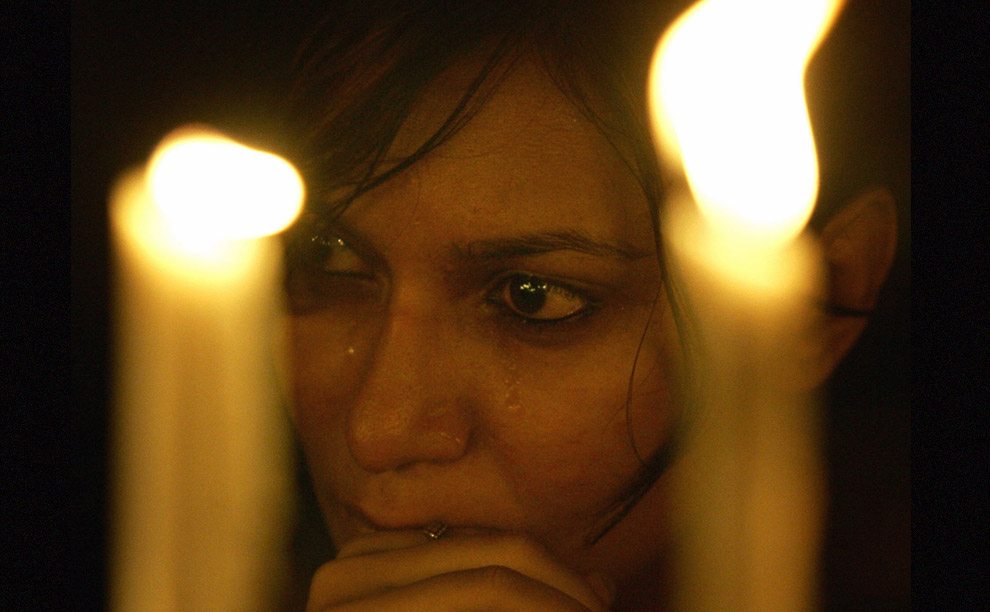
Tuesday, December 30, 2008
Tuesday, December 16, 2008
Bush and the Shoes
BTW , Two giants of Microsoft also had a dose of an irate audience some years back. Steve Ballmer got eggs and Bill gates got a Pie on face. Wtach it on you tube.
Wednesday, December 10, 2008
Calling All Pakistanis -
This is from the author who wrote “ the world is flat” . The questions raised in this article are very relevant. No where in the world , Muslims are known to come together to protest against a humane issue. They only protest when “ Islam “ is in danger which shows their short sight as a fellow human being….
Indian Muslims have at least felt to voice their opinions at this juncture and many have expressed their anguish and pain. But overall across the world – Muslim community chose to remain silent.
the most hilarious comments were made by Paki media that the Mumbai terrorists were Hindus and even found their names – Amar Singh and Hiralal . If you have a common terror enemy , it is time to prove it and take action against those who are known to be responsible and not ask proofs from India at all times.
Mr. Benzair Bhutto ( Zardari) is shit scared to take tough actions against these as I may land tomorrow inside a coffin like Mrs. Bhutto.
anyway .. Pakis wake up and face the reality ….. Sachin
By THOMAS L. FRIEDMAN @ New York Times
Published: December 2, 2008
On Feb. 6, 2006, three Pakistanis died in Peshawar and Lahore during violent street protests against Danish cartoons that had satirized the Prophet Muhammad. More such mass protests followed weeks later. When Pakistanis and other Muslims are willing to take to the streets, even suffer death, to protest an insulting cartoon published in Denmark, is it fair to ask: Who in the Muslim world, who in Pakistan, is ready to take to the streets to protest the mass murders of real people, not cartoon characters, right next door in Mumbai?
After all, if 10 young Indians from a splinter wing of the Hindu nationalist Bharatiya Janata Party traveled by boat to Pakistan, shot up two hotels in Karachi and the central train station, killed at least 173 people, and then, for good measure, murdered the imam and his wife at a Saudi-financed mosque while they were cradling their 2-year-old son — purely because they were Sunni Muslims — where would we be today? The entire Muslim world would be aflame and in the streets.
So what can we expect from Pakistan and the wider Muslim world after Mumbai? India says its interrogation of the surviving terrorist indicates that all 10 men come from the Pakistani port of Karachi, and at least one, if not all 10, were Pakistani nationals.
First of all, it seems to me that the Pakistani government, which is extremely weak to begin with, has been taking this mass murder very seriously, and, for now, no official connection between the terrorists and elements of the Pakistani security services has been uncovered.
At the same time, any reading of the Pakistani English-language press reveals Pakistani voices expressing real anguish and horror over this incident. Take for instance the Inter Press Service news agency article of Nov. 29 from Karachi: “ ‘I feel a great fear that [the Mumbai violence] will adversely affect Pakistan and India relations,’ the prominent Karachi-based feminist poet and writer Attiya Dawood told I.P.S. ‘I can’t say whether Pakistan is involved or not, but whoever is involved, it is not the ordinary people of Pakistan, like myself, or my daughters. We are with our Indian brothers and sisters in their pain and sorrow.’ ”
But while the Pakistani government’s sober response is important, and the sincere expressions of outrage by individual Pakistanis are critical, I am still hoping for more. I am still hoping — just once — for that mass demonstration of “ordinary people” against the Mumbai bombers, not for my sake, not for India’s sake, but for Pakistan’s sake.
Why? Because it takes a village. The best defense against this kind of murderous violence is to limit the pool of recruits, and the only way to do that is for the home society to isolate, condemn and denounce publicly and repeatedly the murderers — and not amplify, ignore, glorify, justify or “explain” their activities.
Sure, better intelligence is important. And, yes, better SWAT teams are critical to defeating the perpetrators quickly before they can do much damage. But at the end of the day, terrorists often are just acting on what they sense the majority really wants but doesn’t dare do or say. That is why the most powerful deterrent to their behavior is when the community as a whole says: “No more. What you have done in murdering defenseless men, women and children has brought shame on us and on you.”
Why should Pakistanis do that? Because you can’t have a healthy society that tolerates in any way its own sons going into a modern city, anywhere, and just murdering everyone in sight — including some 40 other Muslims — in a suicide-murder operation, without even bothering to leave a note. Because the act was their note, and destroying just to destroy was their goal. If you do that with enemies abroad, you will do that with enemies at home and destroy your own society in the process.
“I often make the comparison to Catholics during the pedophile priest scandal,” a Muslim woman friend wrote me. “Those Catholics that left the church or spoke out against the church were not trying to prove to anyone that they are anti-pedophile. Nor were they apologizing for Catholics, or trying to make the point that this is not Catholicism to the non-Catholic world. They spoke out because they wanted to influence the church. They wanted to fix a terrible problem” in their own religious community.
We know from the Danish cartoons affair that Pakistanis and other Muslims know how to mobilize quickly to express their heartfelt feelings, not just as individuals, but as a powerful collective. That is what is needed here.
Because, I repeat, this kind of murderous violence only stops when the village — all the good people in Pakistan, including the community elders and spiritual leaders who want a decent future for their country — declares, as a collective, that those who carry out such murders are shameful unbelievers who will not dance with virgins in heaven but burn in hell. And they do it with the same vehemence with which they denounce Danish cartoons.
Tuesday, December 09, 2008
Twelve steps to shock-and-awe Pakistan’s economy
We have read lots of options about how India should react to Pakistan on the terror issue. This is one of the best which I read till date which uses a very intelligent plan to work India’s way. I am sure , India’s think tank can use some of this to thwart Pakis.
Courtesy : DNA India , original author -R Vaidyanathan
“ I did not anticipate the huge response my inbox received for the article last week (December 2) slamming Pakistan. Many of those who wrote in have sought concrete steps to tackle the Terror Central. The terror attack on world citizens at Mumbai has created revulsion and outrage all over the world. It is imperative that India seize the opportunity provided to destabilise Pakistan.
A stable Pakistan is not in the interest of world peace, leave alone India. Army controls the country and owns its economy. A significant portion of its GDP is due to army-controlled entities (See Military Inc Inside Pakistan’s Military Economy by Ayesha Siddiqa; OUP; 2007). One can easily say that Pakistan Economy and its Army/ISI are synonymous.
Unless this elementary fact is internalised, we are not going anywhere. This implies we should stop talking of a stable Pakistan since a stable Pakistan means multiple attacks on many more cities of India by that rogue organisation ISI, which is the core of the Pakistan Army and the heart of Pakistan’s economy.
Let us not even assume that Zardari is in control. Poor man - he did not trust his own investigators to probe his wife’s assassination - he wanted Scotland Yard to do the job. Now he blabbers that if his investigators are satisfied, then he will initiate action against terrorists sitting inside Pakistan. Periodically, the Pakistan Army likes to present some useful idiots (as Lenin would have called them) as elected representatives and we swoon over such events.
India should take the following steps to destabilise the economy of Pakistan:
Create assets within Pakistan to destabilise Karachi Stock market - it is already in shambles.
In all these, it is important that we do not bring in the domestic religious issues. The target is the terror central, namely Pakistan, and if there are elements helping them here then they also should be punished-irrespective of religious labels. If Pakistan is dismantled and the idea of Pakistan is gone, many of our domestic issues will also be sorted out.Will the Indian elite go for the jugular or just light more candles and scream at the formless/ nameless political class before TV cameras? It is going to be a long haul and may be in a decade or so, we can find a solution to our existential crisis of being attacked by barbarians from the West. We need to combine strategy and patience and completely throw to the dustbin the ‘Gujral Doctrine’ by that mumbling Prime Minister about treating younger brothers with equanimity.
The doctrine essentially suggests that if we are slapped on both the cheeks we should feel bad that we do not have a third cheek to show. He, according to security experts, seems to have dismantled our human intelligent assets inside Pakistan, which has resulted in the gory death of thousands of Indian citizens in the last few years. Such is our strategic thinking in this complex world since our political class is not adequately briefed and the elite don’t think through issues. Better to be simple in our talks and vicious in our actions rather than the other way.
Hopefully, this November attack will create a new vibrant India capable of taking care of its own interests. “The writer is professor of finance and control, Indian Institute of Management - Bangalore, and can be reached at vaidya@iimb.ernet.in. Views are personal.
Wednesday, December 03, 2008
The Taj it was
When I decided to write a blog , I went no further to pick up an icon for my blog. It was the Taj . The Grand Taj Mahal Hotel in Mumbai which stands majestically next to Gateway of India. Sadly I have lost my icon on 26th November . I am praying to God that I get my icon back soon.
Sachin
Mumbai – A city which has taken many blows , but the spirit never dies…
I am still shocked to express my thoughts on what happened in Mumbai on 26th November . I am capturing the mood of Mumbai post this ghastly act of terror. The questions which I raised a few months back still remain unanswered .. I hope the new collective movement by common Indian can find answers to some of those.
Let us fight terror together……. Sachin
~:: Mumbai After The Smoke Has Cleared ::~
On Monday most of Mumbai, India attempted a return to normal activity, in the wake of the 60-hour-long siege last week. Some facts about the attacks are a bit clearer now, others still hazy. Based in part on the confessions of the only terrorist captured alive - Azam Amir Kasav (also identified elsewhere as 'Ajmal Qasab'), Indian officials now say that there were only 10 gunmen involved, all members of Lashkar-e-Taiba, a Pakistani militant group with links to the disputed Himalayan region of Kashmir - though Pakistan officially denies any involvement. According to recent reports, the ten attackers were responsible for the deaths of 172 people, including 19 foreigners, and 239 wounded. While mourners of the victims attended to their loved ones, and people all over the world held vigils, a Muslim graveyard in Mumbai refused to bury the nine dead gunmen - an official saying that they were not true followers of the Islamic faith.
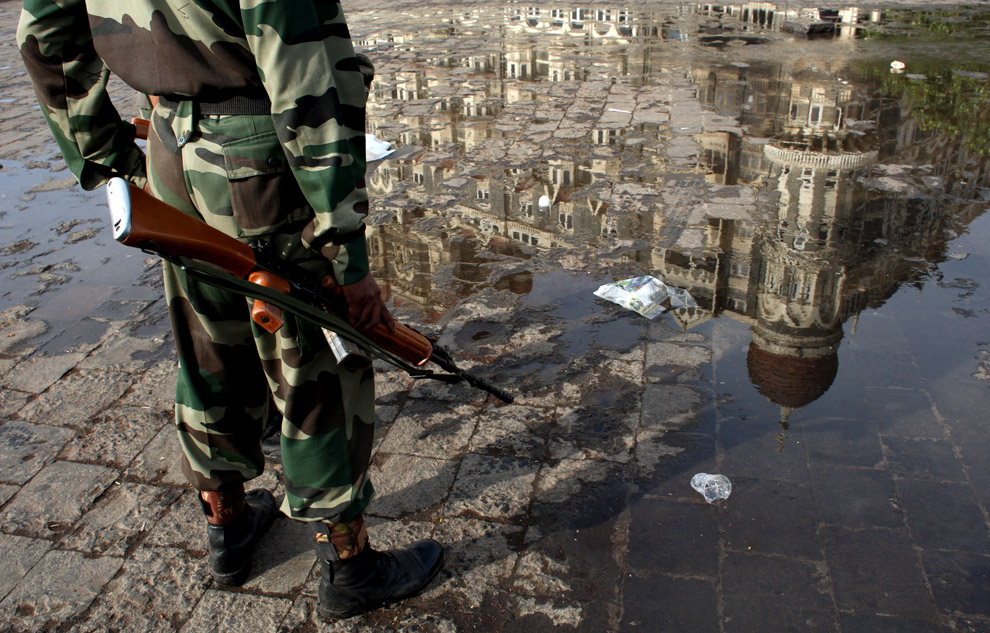
An Indian soldier stands guard outside the Taj Mahal Palace & Tower Hotel following an armed siege on November 29, 2008 in Mumbai, India.
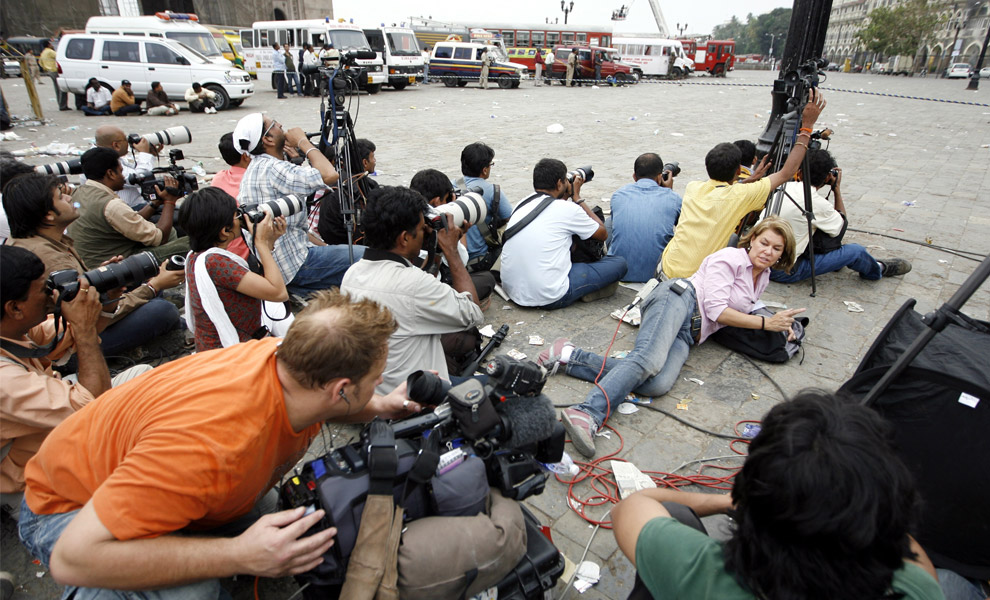
Photographers and members of the media cover a gunfire at the Taj Hotel in Mumbai November 28, 2008. At the front of the Taj, bleary-eyed journalists who had earlier mobbed National Security Guards chief J.K. Dutt when he announced the end of the siege were pushed back roughly behind a rope that had marked an unofficial boundary for them. Hundreds of media workers dived for cover as stray bullets whistled above them during the final stages of a firefight.
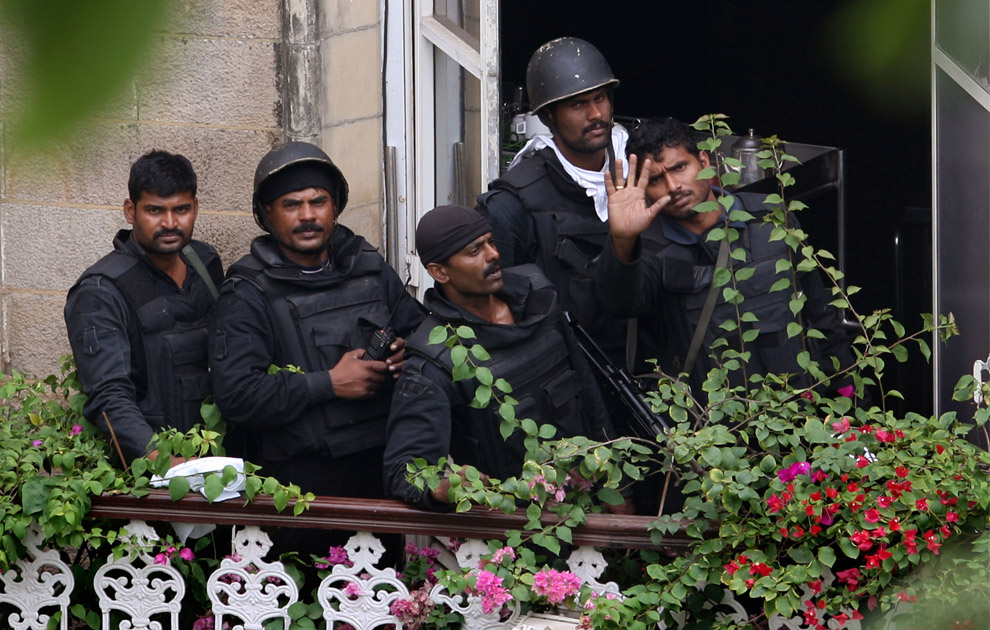
3
Indian commandos stand on a balcony of the Taj Mahal Palace & Tower Hotel after they gained control of it, on November 29, 2008 in Mumbai, India.
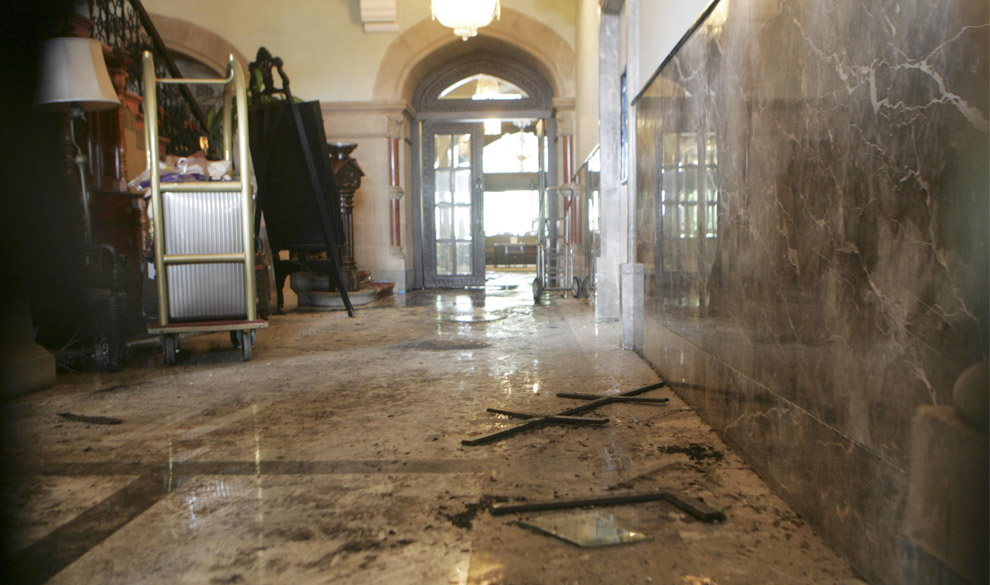
4
The lobby area of the Taj Mahal Hotel is seen in Mumbai, India, Saturday, Nov. 29, 2008, shortly after Indian commandos killed the last remaining gunmen holed up at the luxury Mumbai hotel Saturday.
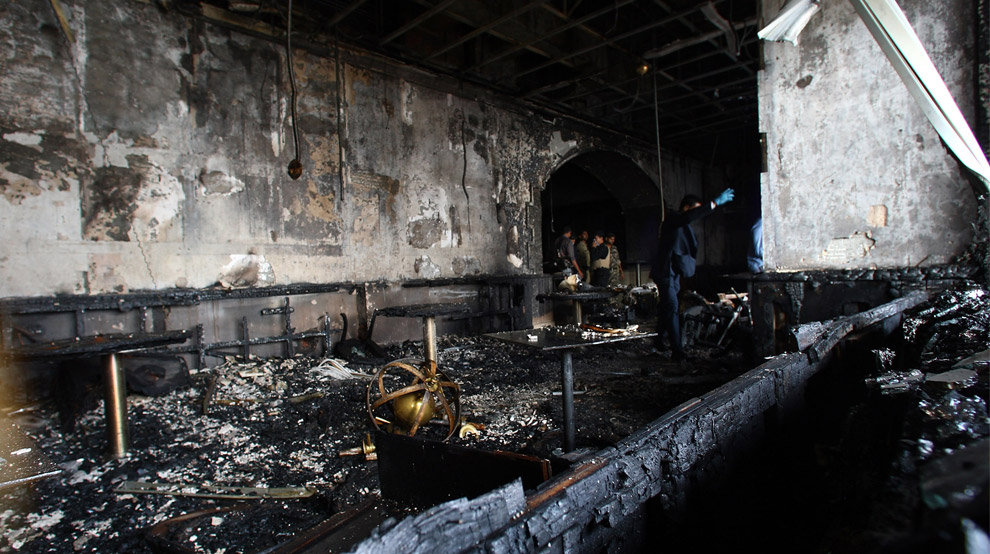
5
MSecurity officials survey a destroyed room inside the Taj Mahal Palace & Tower Hotel after the armed siege on November 29, 2008 in Mumbai, India.
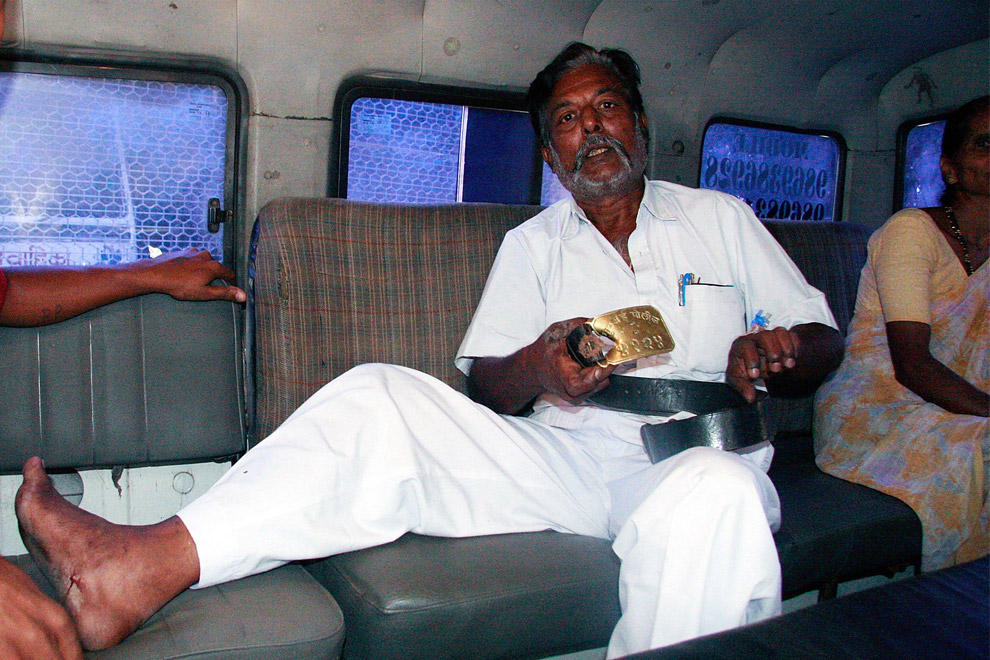
6
A policeman, shot at five times, holds up his metal belt buckle which saved his life on November 29, 2008 in Mumbai, India.
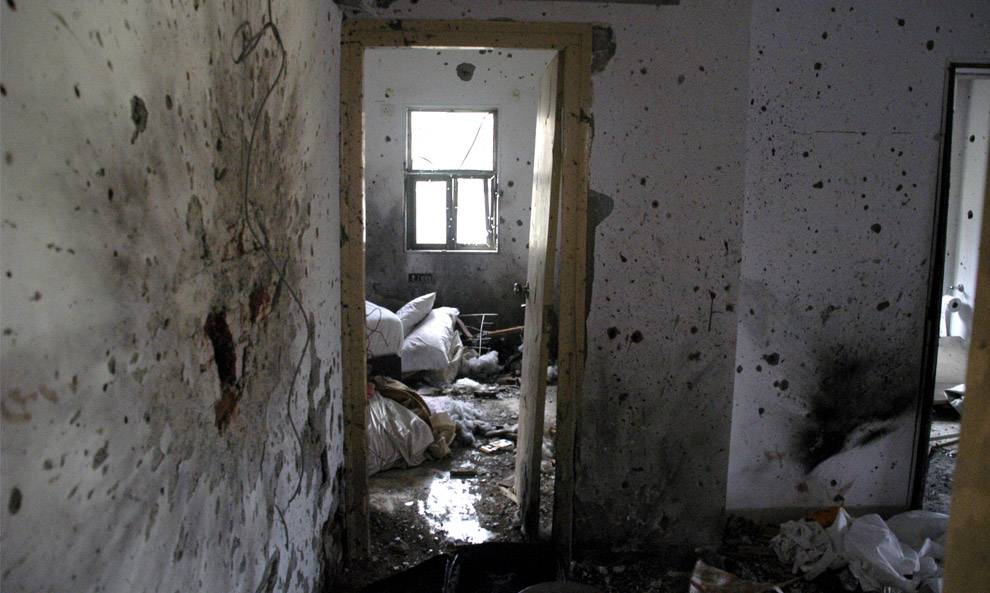
7
The interiors of Nariman House, Mumbai headquarters of the ultra-Orthodox Chabad Lubavitch movement, are seen after the commando operation in Mumbai, India, Saturday, Nov. 29, 2008.
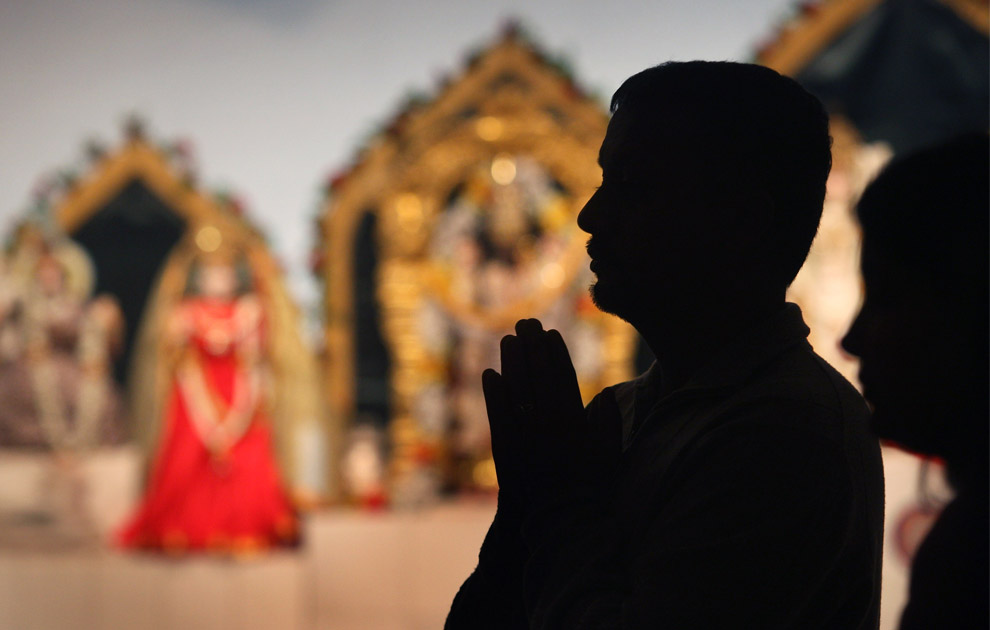
8
A member of a Hindu congregation holds his hands in prayer to mourn those killed in the Mumbai, India terrorist attacks, while at the Hindu Temple and Cultural Center of the Rockies November 29, 2008 in Littleton, Colorado. The congregation listened to a prayer and then paused for two minutes of silence in solidarity with those killed in the attacks.
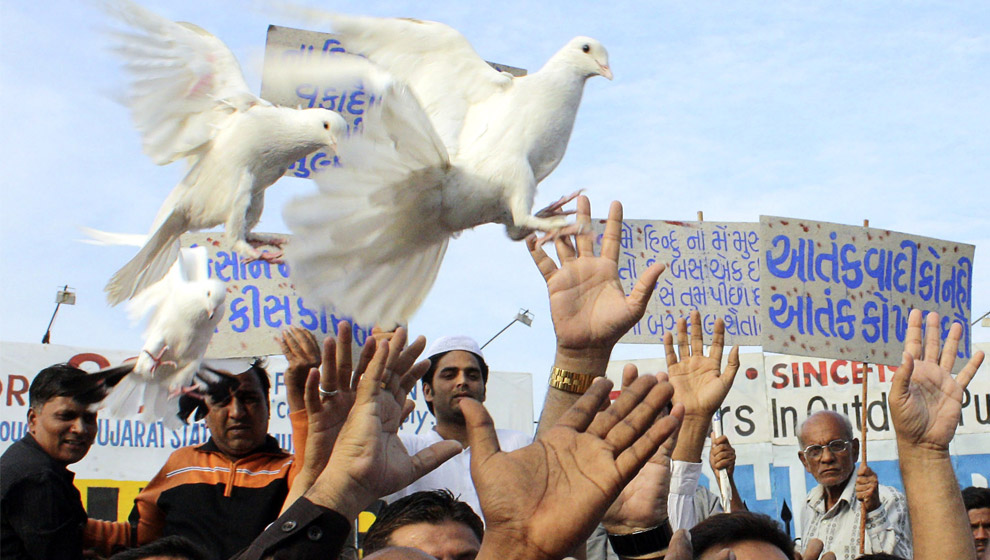
9
Muslims release pigeons symbolising peace during a rally in the western Indian city of Ahmedabad against the Mumbai attacks November 29, 2008.
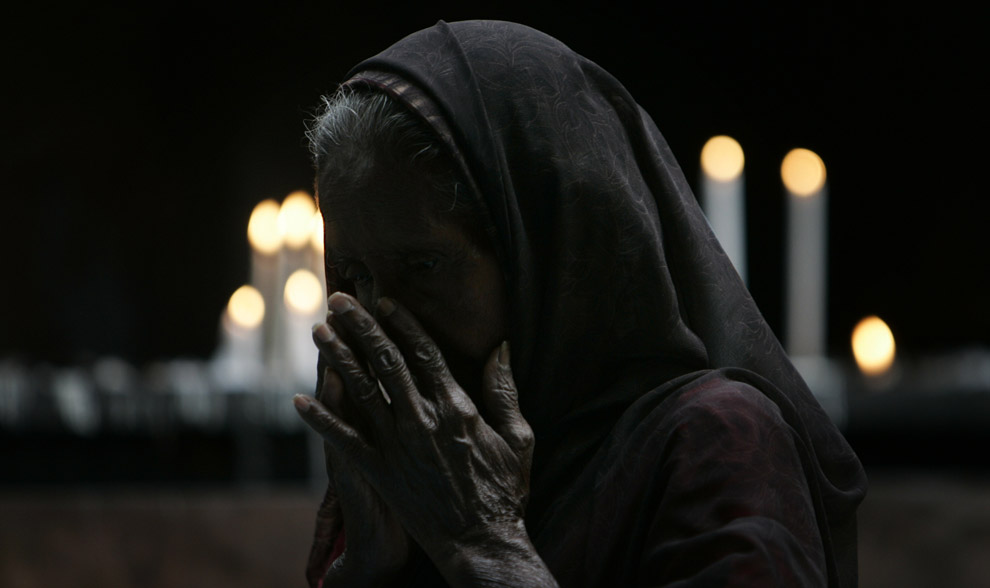
10
An Indian Catholic woman prays following a Sunday Mass, at the Cathedral of the Holy Name, in Mumbai, India, Sunday Nov. 30, 2008.
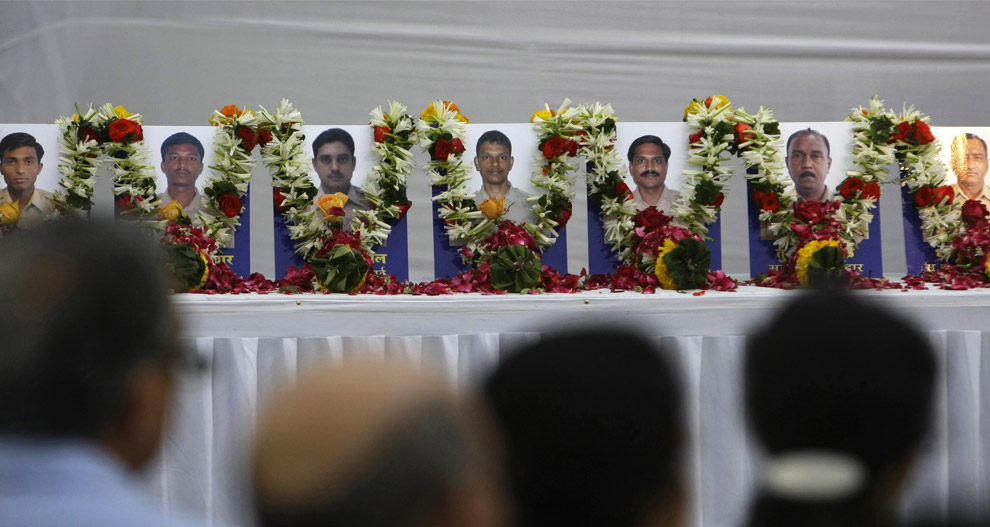
11
Policemen and their families attend a meeting to pay tributes to Mumbai's policemen, in photographs in background, who lost their lives in terrorist attacks in Mumbai, India, Sunday, Nov. 30, 2008.
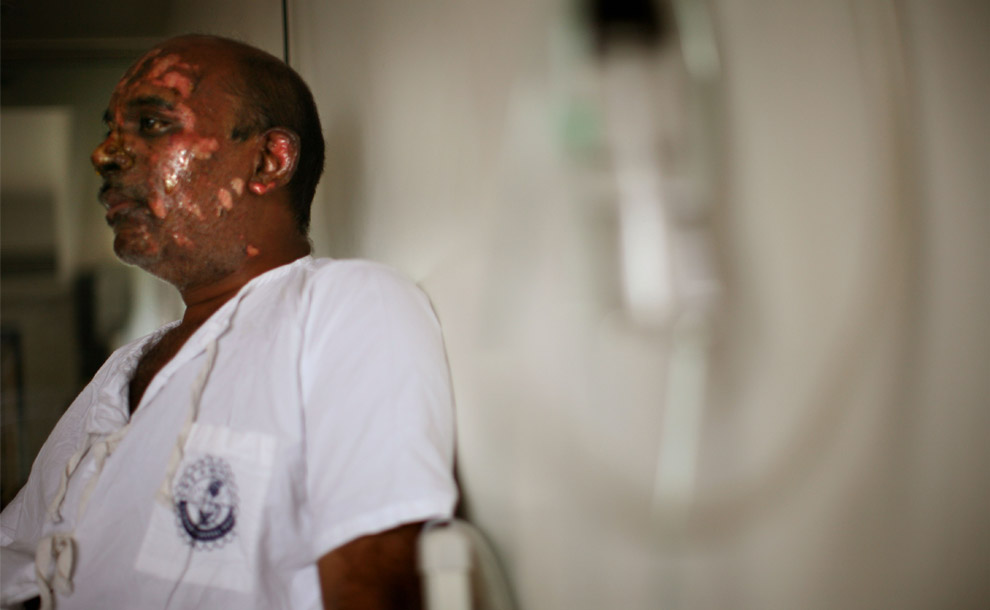
12
Dhole Deepk, a policeman who was wounded at the Taj Mahal Palace & Tower Hotel during the armed siege with militants that ended yesterday, is seen at the Mumbai hospital, on November 30, 2008.
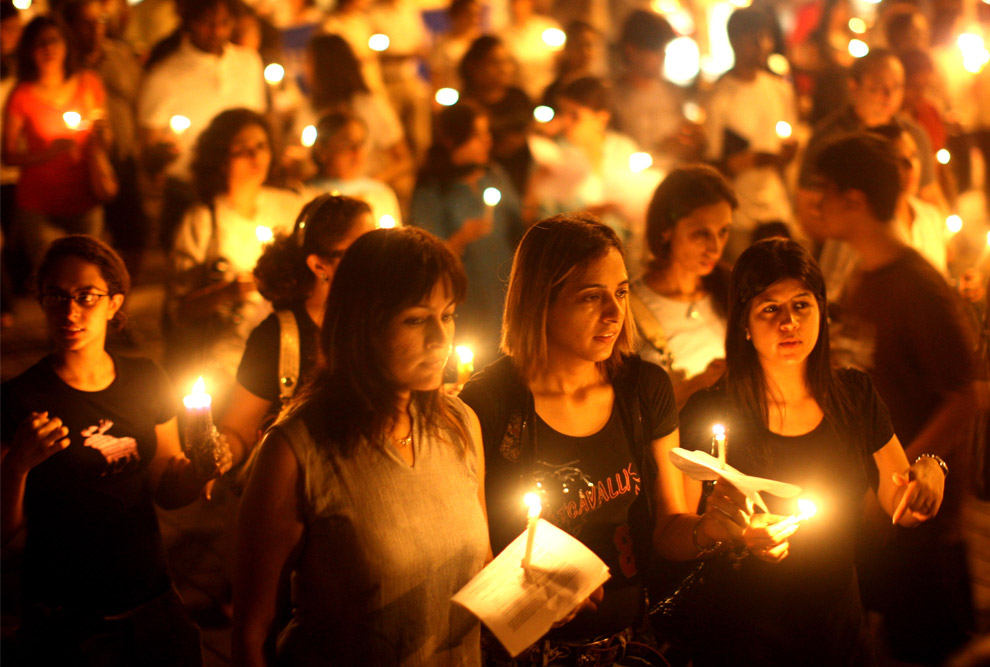
13
Mumbai Residents walk with candles in the street near The Oberoi Hotel during a demonstration against the recent terror attacks in the city on November 30, 2008 in Mumbai, India.
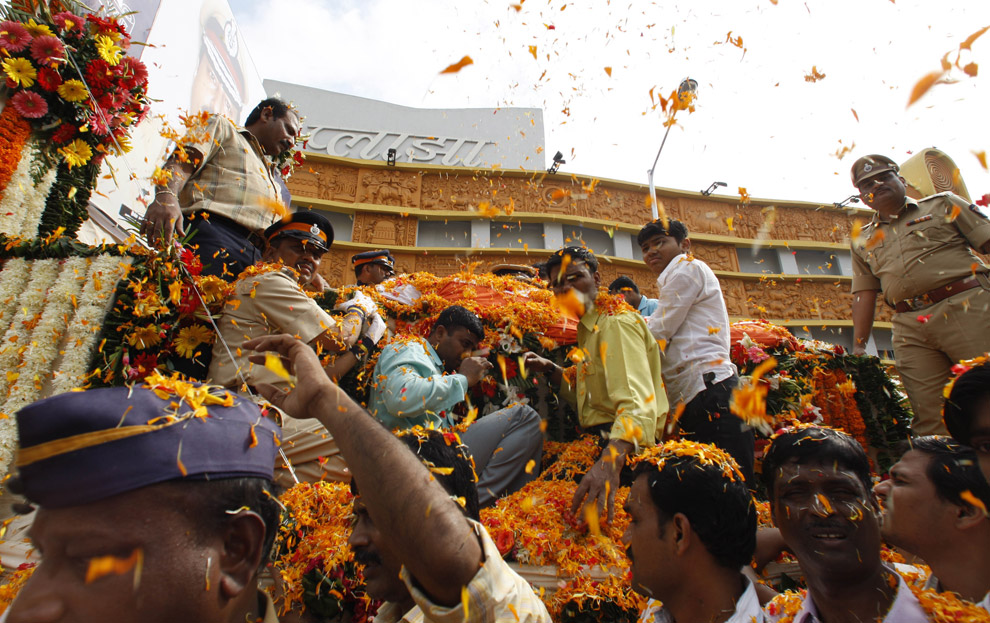
14
People standing on the roadside shower flower petals as the body of Hemant Karkare, the chief of Mumbai's Anti-Terrorist Squad is taken for cremation in Mumbai, India, Saturday, Nov. 29, 2008.
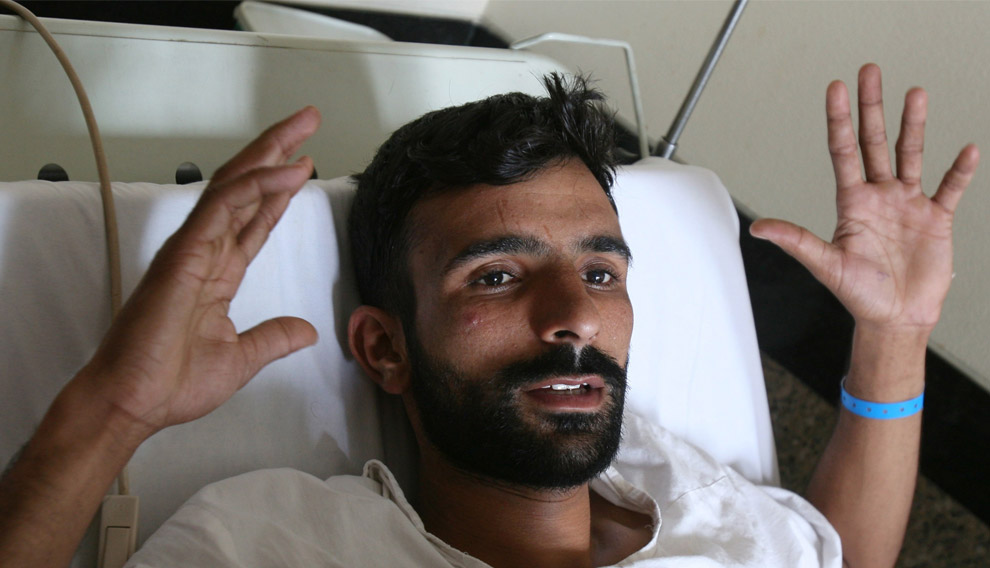
15
Sunil Yadav, A National Security Guard (NSG) commando who was injured during an operation in the Taj Mahal hotel, shares his experience with media in a hospital in Mumbai November 30, 2008.
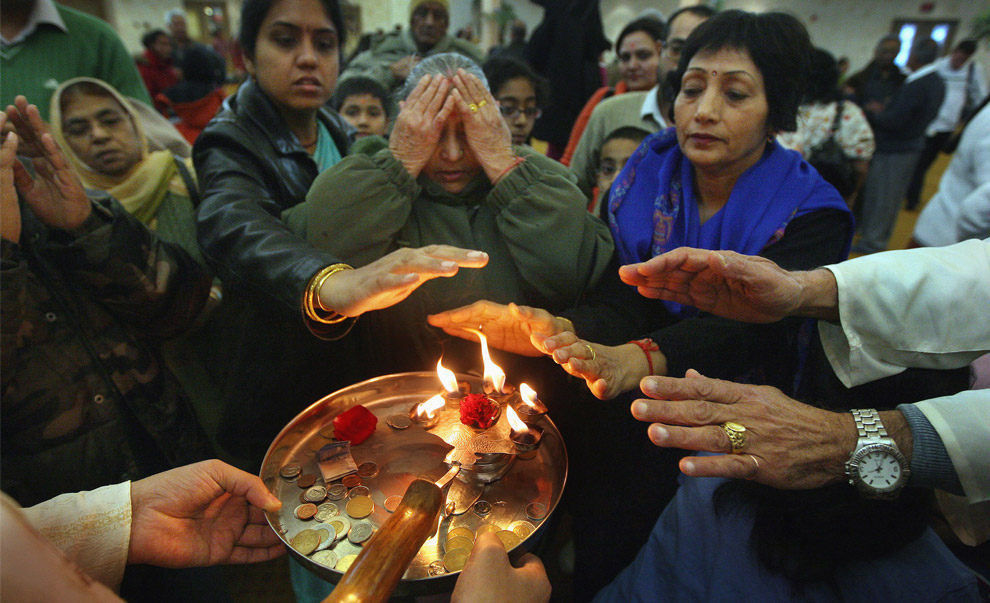
16
People make offerings and take the aura from the light of the Artee, at the end of an inter-faith service at the Hindu Sabha Temple in support of Mumbai attack victims, in Brampton, Canada. on Sunday Nov. 30, 2008.
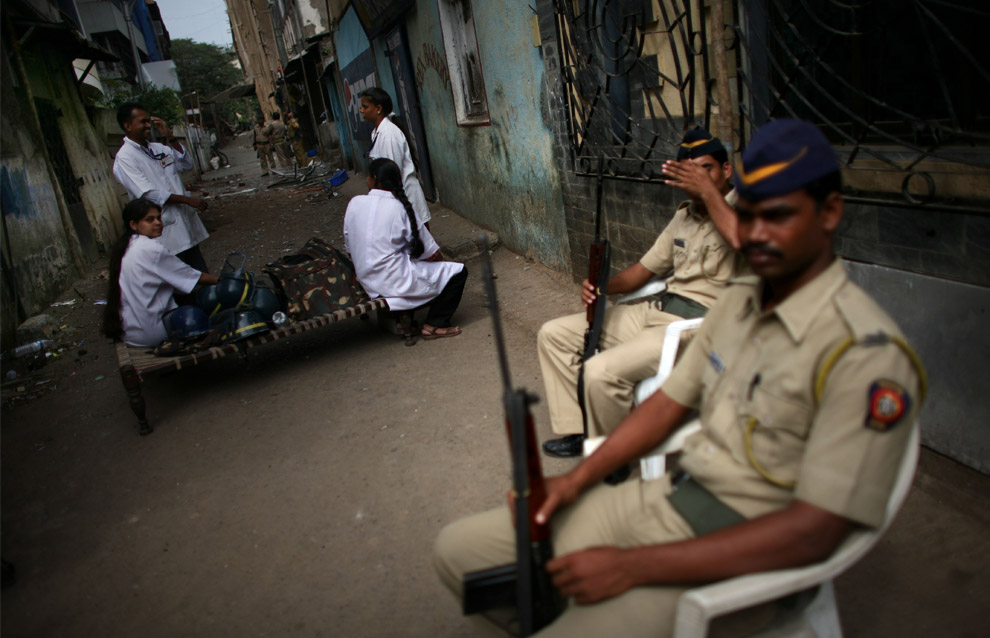
17
Forensic experts sit outside the Nariman House Jewish centre, which is guarded by police, at Colaba Market on November 30, 2008 in Mumbai, India.
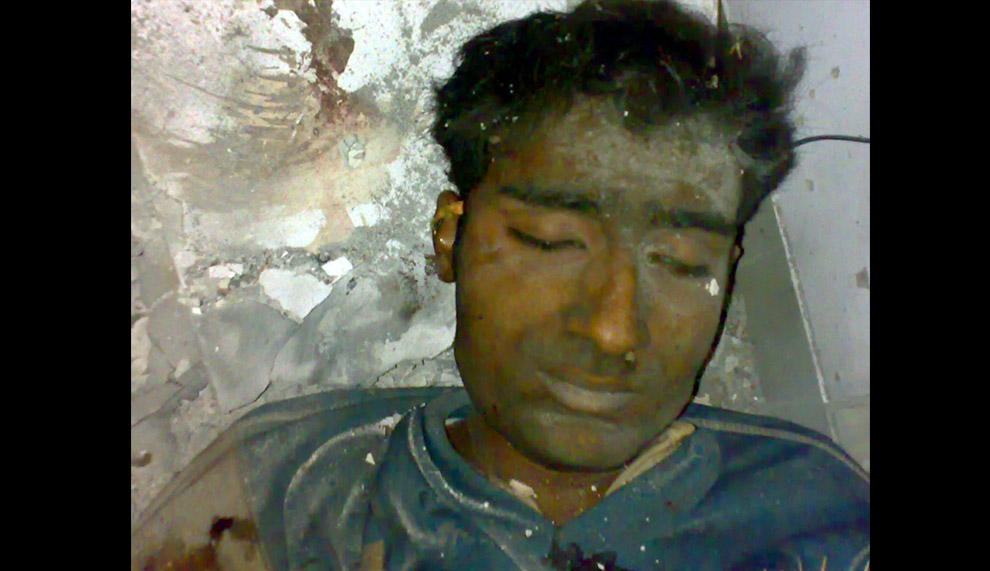
18
The body of a suspected terrorist lies in the wreckage inside the Nariman House building in Mumbai November 28, 2008.
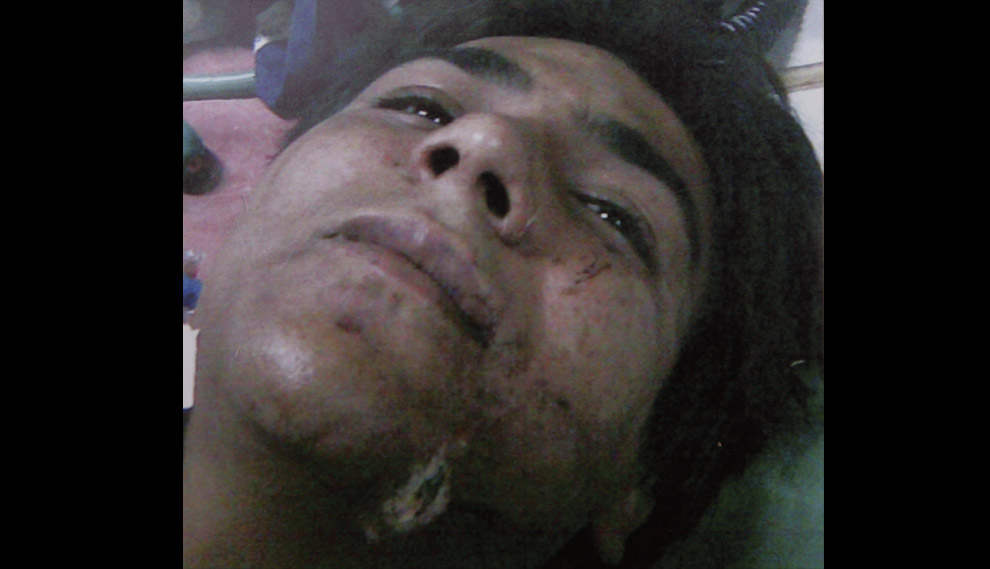
19
This is an undated image released by Mumbai State police department on Monday Dec. 1, 2008, of Azam Amir Kasav who the police said was the sole terrorist captured alive in the recent attacks in Mumbai. Kasav is purported to be the same terrorist photographed in the act here.
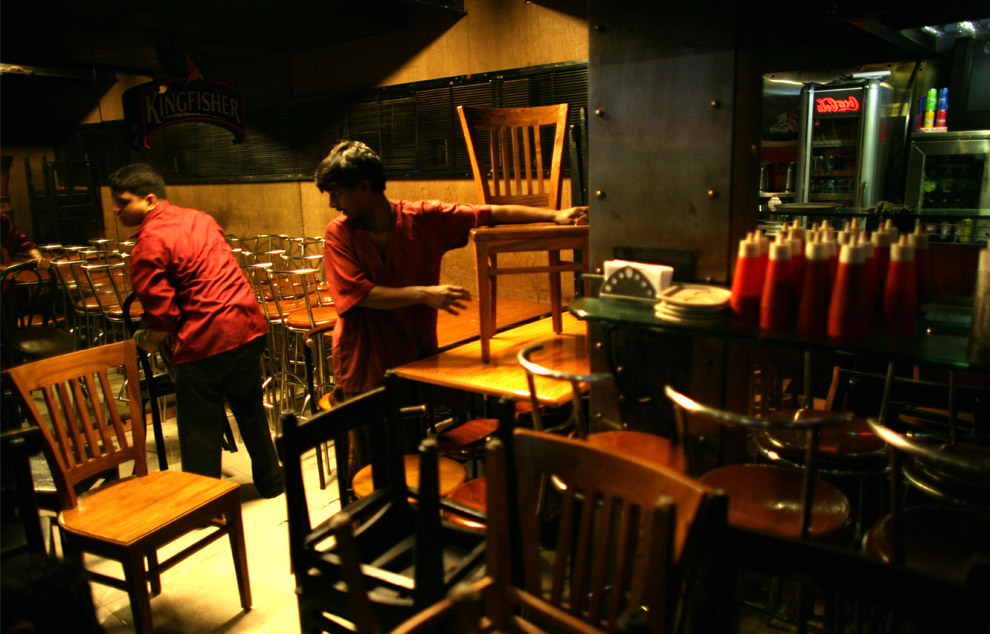
20
Waiters organize for reopening the site of the first target of terrorist attacks this week, the Leopold Cafe on November 30, 2008 in Mumbai, India.
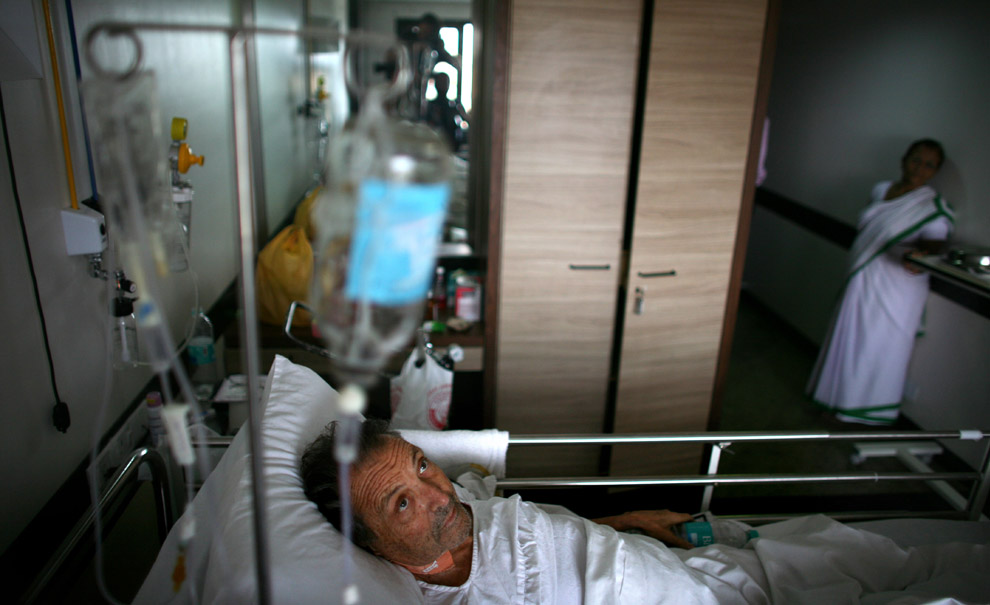
21
Raflles Eeaus Codes, a tourist from Spain who was wounded at the Taj Mahal Palace & Tower Hotel, lays in a bed at the Mumbai hospital on November 30, 2008 in Mumbai, India.
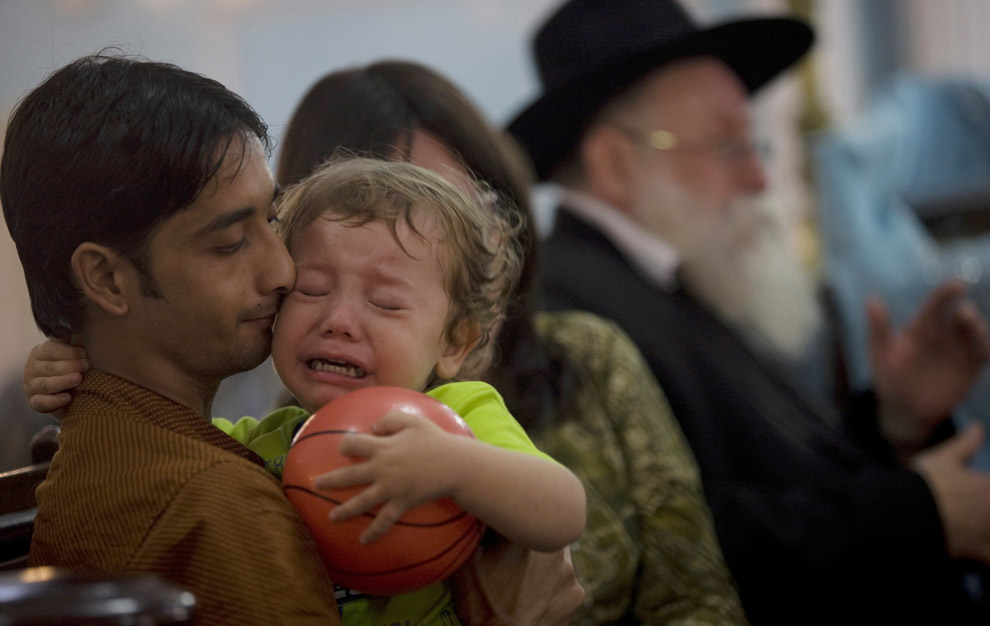
22
Moshe Holtzberg, the 2-year-old orphan of the rabbi and his wife slain in the Mumbai Jewish center, cries during a memorial service at a synagogue in Mumbai, India, Monday, Dec. 1, 2008. Holtzberg will fly to Israel Monday on an Israeli Air Force jet with his parents' remains and the Indian woman who rescued him, an Israeli Foreign Ministry spokesman said.
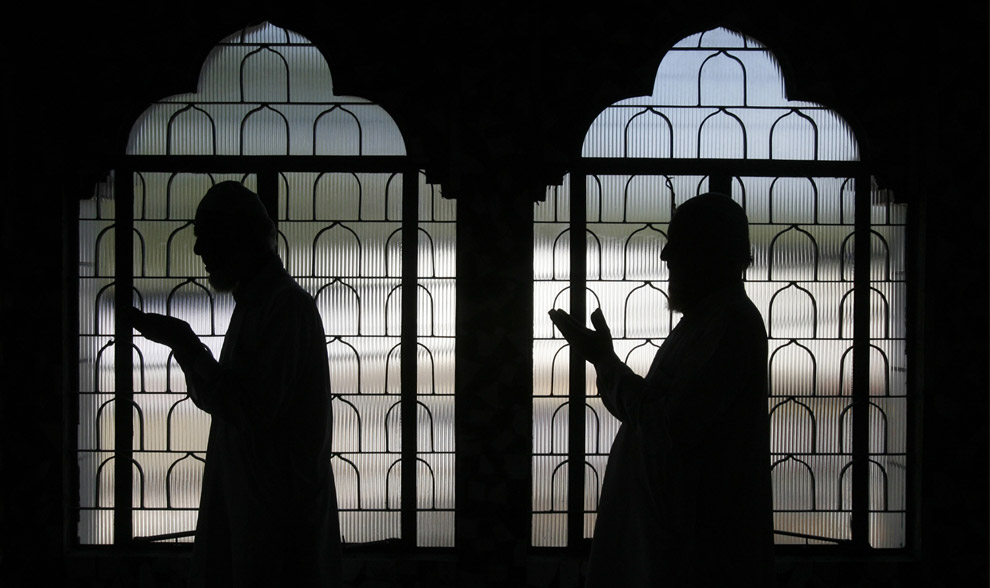
23
Muslims pay homage to the victims of the Mumbai attacks during a special prayer meeting at a mosque in the northeastern Indian city of Siliguri November 29, 2008.
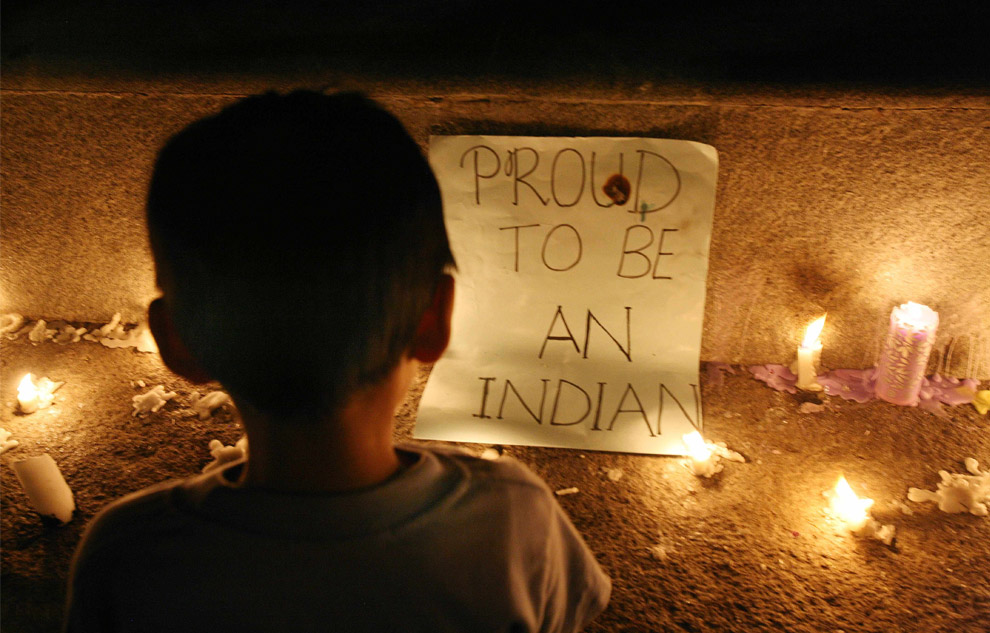
24
A boy attends a candle lighting ceremony in Mumbai, India on Sunday, Nov. 30, 2008.
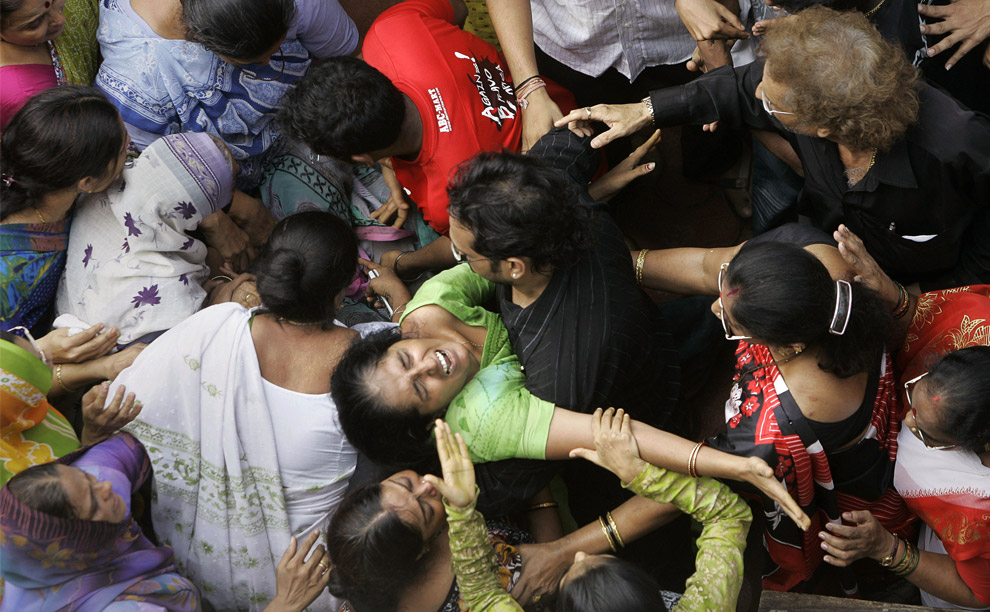
25
Relatives and neighbors mourn as they attend the funeral of Haresh Gohil, 25, who was killed by gunmen near Chabad-Lubavitch center,also known as Nariman House in Mumbai, India, Saturday, Nov. 29, 2008.
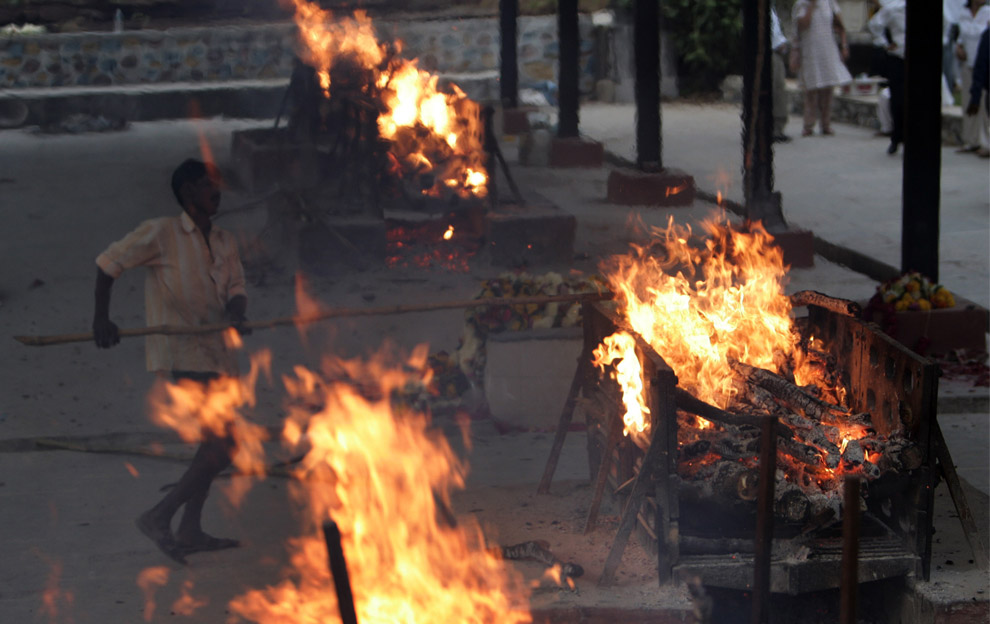
26
Several burning funeral pyres of victims who died in the attacks in Mumbai, India, Saturday, Nov. 29, 2008.
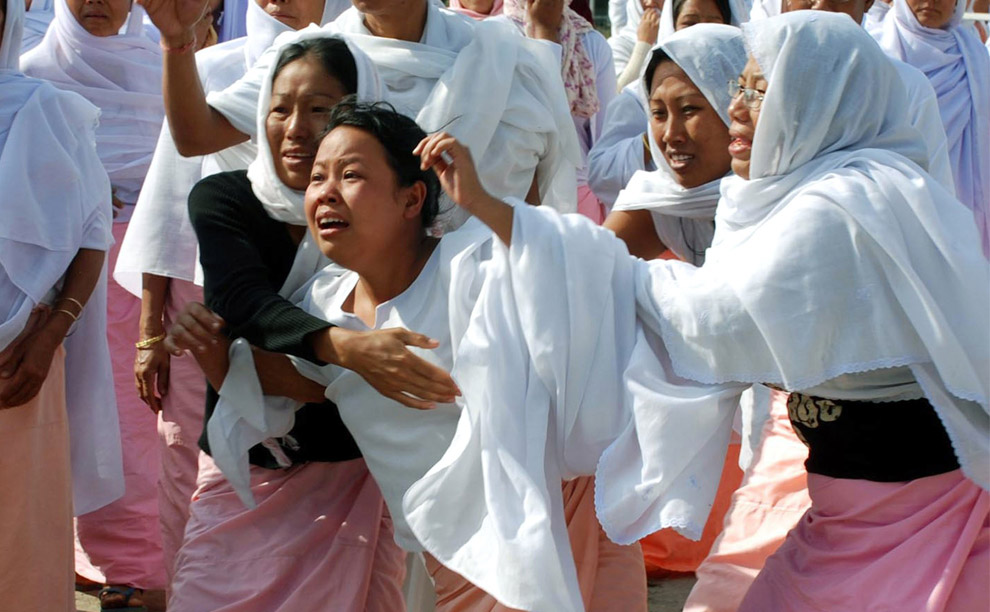
27
Family members of Maibam Bimolchandra Singh react as his body is brought to his hometown Imphal November 29, 2008. Singh, an employee in the Trident-Oberoi hotel in Mumbai, died in the Mumbai attacks.
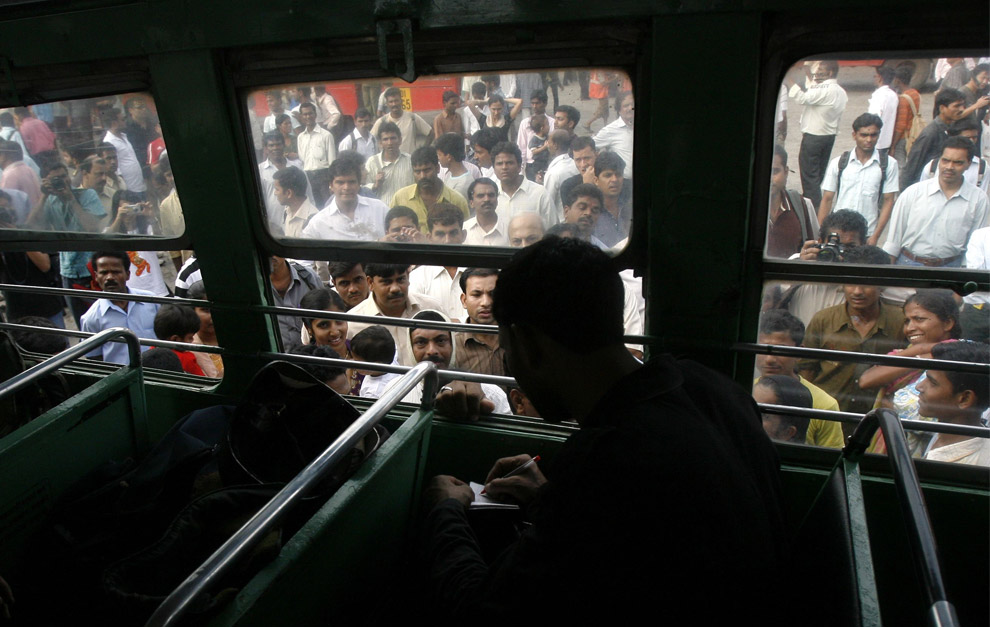
28
An Indian commando signs autographs for a crowd of grateful people in Mumbai November 29, 2008.
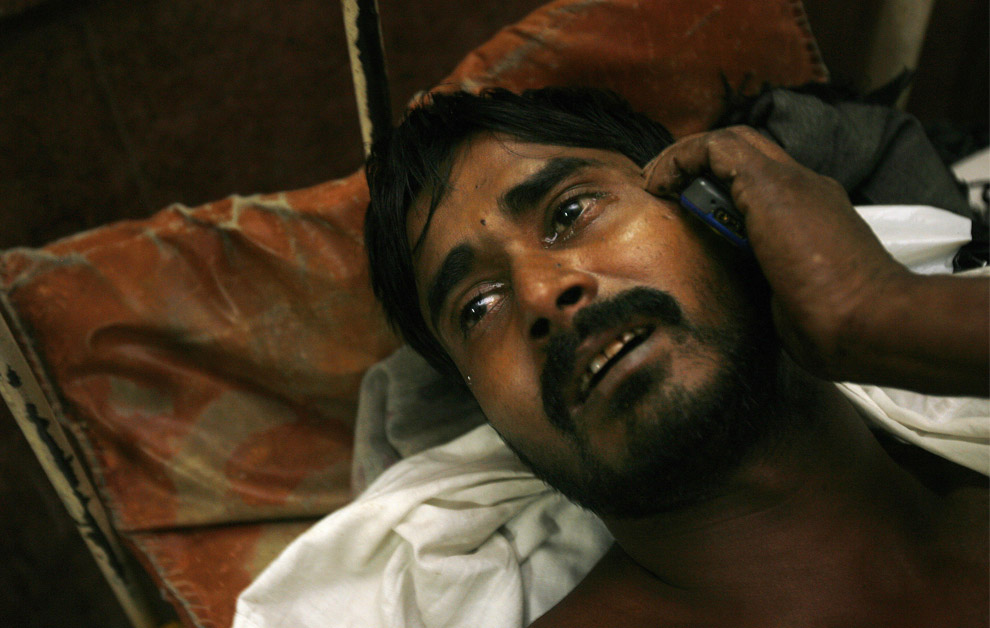
29
Manoj Kanojia, 27, cries as he speaks to his mother on the phone at a hospital in Mumbai, India, Saturday, Nov. 29, 2008. Manoj suffered two bullet wounds in Wednesday's shooting at the Chhatrapati Shivaji Train Station in Mumbai.
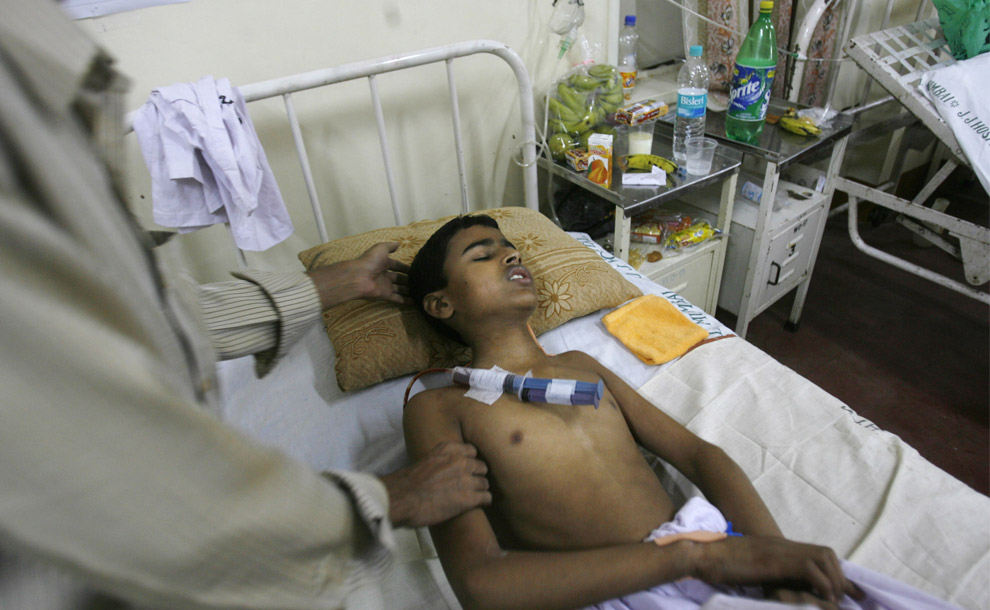
30
Afroz Abbas, age 10, winces as he is helped to lie down on his bed at a hospital in Mumbai, India, Saturday, Nov. 29, 2008. Afroz was injured in the back and said he lost his parents and three other relatives in Wednesday's shooting at the Chhatrapati Shivaji Train Station in Mumbai.
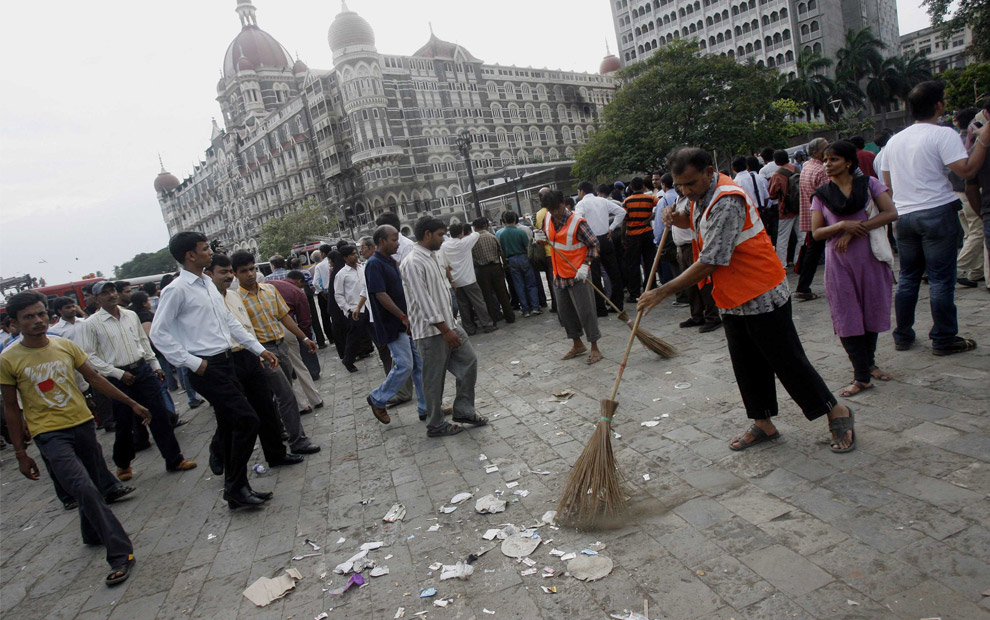
31
Workers sweep the ground in front of the Taj hotel in Mumbai November 29, 2008.
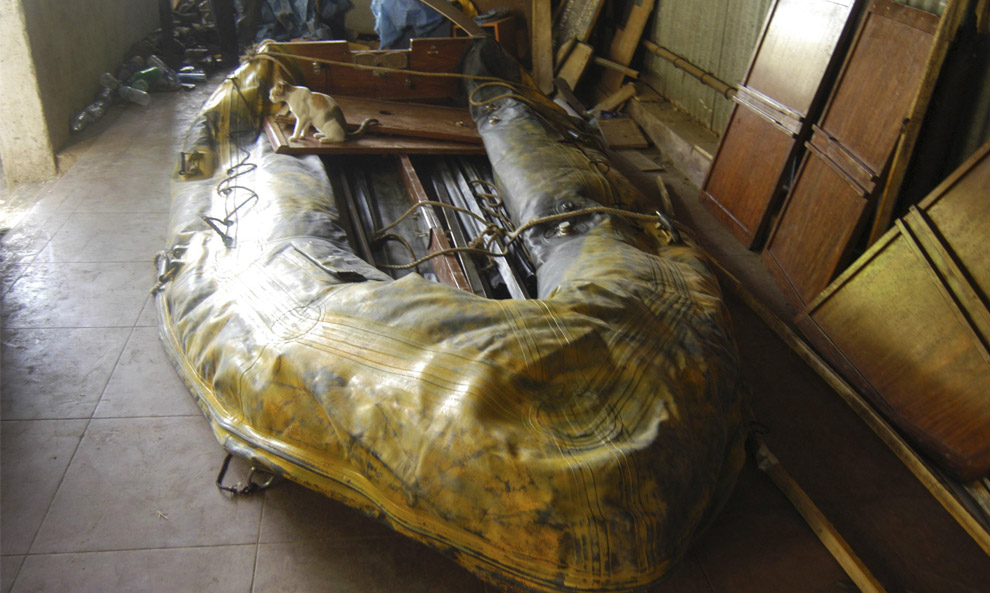
32
A rubber dinghy lies in a police station in Mumbai, India, Thursday, Nov. 27, 2008. Indian security officers believe the gunmen who went on a terror rampage in Mumbai may have reached the city using a black and yellow rubber dinghy found near the site of the attacks.
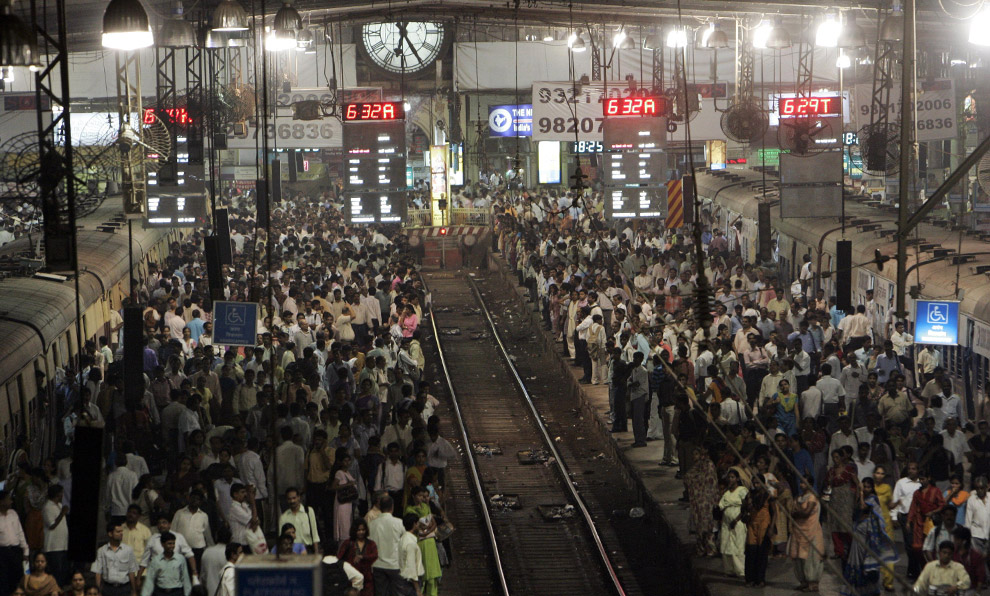
33
People wait on the platforms of the landmark Chhatrapati Shivaji Terminus train station, one of the several places where the attackers shot at people, in Mumbai, India, Monday Dec. 1, 2008. Mumbai returned to normal Monday to some degree, with many shopkeepers opening their doors for the first time since the attacks began. As authorities finished removing bodies Monday from the bullet and grenade-scarred Taj Mahal hotel, a Muslim graveyard refused to bury the nine gunmen who terrorized this city over three days last week, leaving at least 172 people dead and wreaking havoc at some of its most famous landmarks.
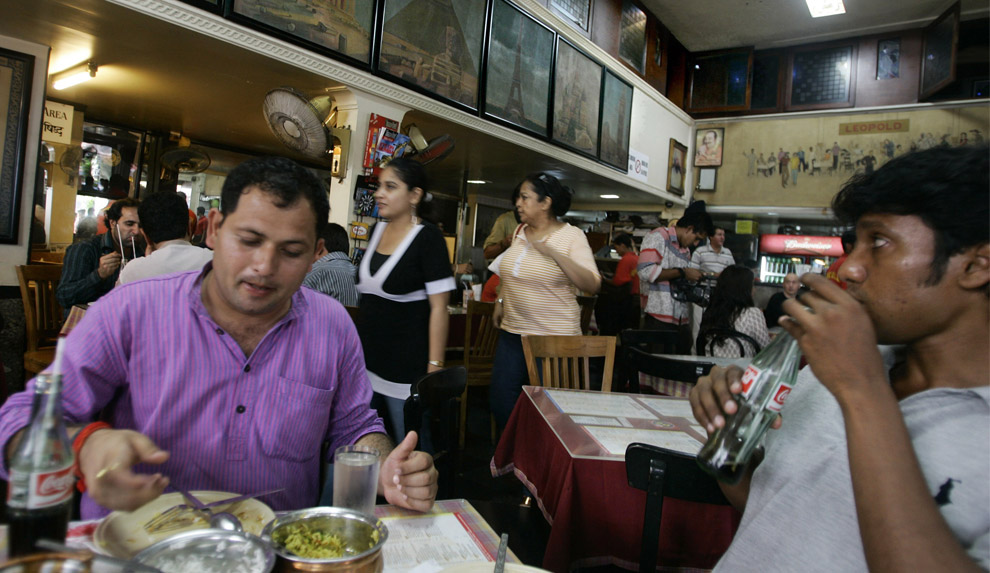
34
People eat at Cafe Leopold, one of the several places where terrorists shot at people, after it reopened in Mumbai, India, Monday, Dec. 1, 2008.
35
A woman cries, during a candlelight march for the victims of the Mumbai terrorist attack in which more than 195 people were killed, in Mumbai, India, Saturday, Nov. 29, 2008.

